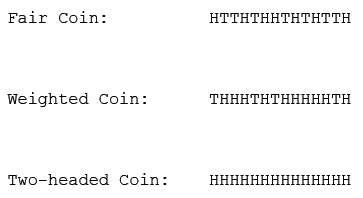SS-week2
Information Theory
Information Storage
訊號分成 analog 跟 digital
大致討論的結果(只記得這些…)
| type | pros |
|---|---|
| digital | 電腦可讀 可驗證 易編輯 |
| analog | 能保存較原始資料 |
2000年後 digit 資料量爆炸性成長

Information Value
More Information?
左邊 還是 右邊 給我們比較多的資訊???

幾乎大家一致認同左邊
但那是因為左邊是我們認得的語言
想像如果右邊是另一種語言
可能不同的音調、個數、行數等等都代表不同意義
這樣右邊會不會也是能帶給我們跟左邊一樣的資訊量呢🤔🤔🤔
Measure Information value
那我們又如何衡量資訊的價值呢?
試問下面三個投擲硬幣的結果
那一個sequence比較有價值?

Hint : 隨便挖掉其中一個擲硬幣的結果,你有辦法填回去嗎?
明顯的two-head coin 我們可以直接填H回去
weighted coin 我們會猜H(H 出現機率比較大)
而fair coin 我們就無法做出猜測
Information Entropy
disorder, unpredictability, uncertainty of information
(記得高中老師說熵就是亂度
以下的計算皆以密碼為例
可用字元 b 個
密碼長度 n 個
可用密碼數(combinations)
$$
b^{n}
$$
存儲密碼所需要的位元數(bits of entropy)
$$
\log{b^{n}}
$$
Shannon Entropy( Entropy of given set of characters)
整串密碼中每個字的平均消息量
How many questions would we expect to ask to find an element from a set of characters?
char出現時所需要問的次數的期望值
= 每個char出現的機率 * 出現時所需要問題次數formula
$$
H(X) = E[I(X)] = E[-\ln(P(X))]
\
H(X) = \Sigma{P(x_i)I(x_i)} = - \Sigma{P(x_i)\log_b{P(x_i)}}, b = 2
$$
- implement
1 | def entropy (str) |
但當我們在用Shannon Entropy下去對密碼做分析的話
| password type | sample password | bits of entropy | Shannon Enrtopy |
|---|---|---|---|
| length = 8, lowercase letters only | cvobmsla | 37.60 | 3.0 |
| length = 8, lowercase + uppercase letters | jAcieDlq | 45.60 | 3.0 |
| length = 8, letters + digits | bA29Fs4f | 47.63 | 3 |
| whole words (4 words chosen at random from 2048 word dictionary) |
placidmealerrorpast | 44 | 3.53 |
增加了char,密碼變的更複雜,但似乎沒有增加enyropy
反而是原先認為容易被字典攻擊法攻擊的whole word 表現不差
而且雖然英數字組合的bits of entropy高,但人類不會偏好隨機的組合
因此實際會被用的組合數還要再下修
反觀whole word的組合數就是真實中的problem space -> 沒有捷徑猜密碼
People who don’t understand information theory and security
別期待user會使用隨機組合的密碼
(譯: 過去二十年,我們努力讓每個人用人類更難記,但電腦很好猜的密碼)
後面是開發環境介紹跟一些bit operation
我就略過
但要特別筆記一下XOR
真值表大家都會記
重點是xor有這個特質
$$
P \oplus K = C
\
C \oplus K = P
$$
這個magic讓xor在一些地方有神奇功用
例如
- 兩數互換不用第三個變數
1 | void swap(int *a, int *b){ |
One-time Pad Cipher(week4)
某天寄來的code challenge
implements function
xor product(N,M) = N ^ N+1 … ^ M-1 ^ M
要求
complexity O(log(N))
mem space usage O(1)
其實看到log(N)就大概想應該是要binary下去找
後來看到一個解法
令f(n) = xor product(0,n)
發現有規律
0000 <- 0 [a]
0001 <- 1 [1]
0010 <- 3 [a+1]
0011 <- 0 [0]
0100 <- 4 [a]
0101 <- 1 [1]
0110 <- 7 [a+1]
b(n) 用來查表 求出 xor product(0,n) 跟 xor product(0,m)
兩個再做xor 就會變成 xor product(n,m)